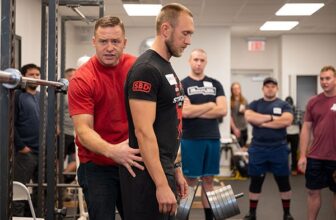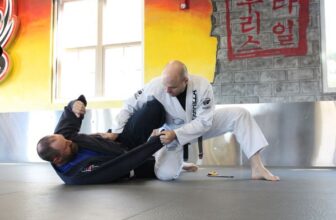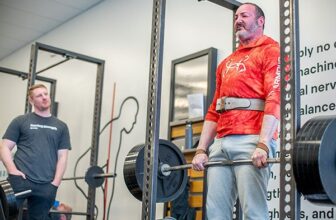
[adinserter block=”2″]
Before the advent of the internet and social media, it was hard to keep up with current events in the world of lifting. The muscle magazines were, unfortunately, limited to their print schedule. If an event took place in December, for instance, you would not find out the results until the magazines published the event several months later. And even if a contest was covered by television, you still had to wait for a few lousy minutes of edited coverage months after the fact.
When Powerlifting USA first came out in the late 1970s, it was the first time that a magazine was devoted strictly to the sport of super-strength. Contest coverage was a big part of the magazine’s contents, and it was a great way to keep up with what was going on in the sport. Eventually, there would be the “Power Hotline,” a twice-weekly newsletter that provided coverage that was even more current and up to date. Naturally, the internet changed our concept of what is current. We no longer had to wait to see record-breaking lifts being performed. Even contests that took place overseas were just a click away.
Past experience with new things tends to indicate the results will be both good and bad. While we were able to receive information almost instantly, we have also been subjected the downside of instant information. The cringe-worthy things that take place on a daily basis in commercial gyms are now there for all of us to see. And let me tell you, there is a lot to see, little of which is good.
One thing that I’ve noticed lately is the increasing number of “lifters” who claim to be “raw.” Now, the definition of “raw” insofar as it relates to lifting has also evolved over the years. When I was competing, there used to be many Raw contests from which to choose. Basically, a raw contest was one where the use of supersuits, wraps, support gear of any kind was not permitted. Basically, you were allowed to wear a wrestling singlet, or a t-shirt and shorts. No supersuit of any kind. Likewise, there was to be nothing on your knees, elbows, or wrists. Even your belt had to be made of leather, none of the thick, suede belts used in most meets. You were truly “Raw.” Naturally, your squat poundage took a hit, as did your bench, that is if you were used to benching with a bench shirt. Fortunately, I was used to benching with only a t-shirt so I was not affected by the rules. Also, if you wee used to wearing a special “Erector” shirt for deadlifting, then your deadlift took a hit, too. The plus side to all of this is that what you lifted at the contest was a true reflection of your actual strength. The results of the contest were not decided by the quality and/or type of supportive gear you were wearing, because there was none.
Lately, I’ve seen a lot of videos and social media posts from people ( I will not refer to them as lifters) who claim to be raw. They will usually post a picture or video of their latest PR in the squat, bench, or deadlift. The funny thing is that what constitutes raw lifting is a far cry from the original definition of the word. Since when is wearing knee wraps considered raw? I can’t tell you how many times I’ve seen a “raw: lifter setting up to do a squat while wearing wraps on his knees and wrists. To say nothing of the fact that he/she is using a Monolift and having any number of “spotters” actually touching the bar as it is being lowered and raised. Does anyone actually believe that someone who is wrapped to the gills, and has a spotter behind him with their arms wrapped around his waist the whole time, and lowers himself into a partial squat and then has the loaders rack the Monolift once the lifter has “completed” the lift, does anyone believe that this is anything near a legitimate lift? If you do, then I’ve got some Yankee world series tickets I’d like to sell you.
Let’s go to the Bench Press. How many times have you seen someone wearing one of those slingshot bench shirts get set up to do a “record” bench? He/she is wearing wrist wraps as well as elbow wraps. The spotter will hand the bar off, but will not let go. His hands are on the bar the entire time, from the descent through the ascent. Most of the time there is no pause whatsoever, which is just as well because most of the time, the lift is not even locked out to completion. At about the ¾ mark, the spotter will take the bar and rack it. If the camera angle is right, you can see that the lifter in question has his/her butt coming off the bench and their feet are anything but stationary. Sometimes I find it difficult to find one actual rule that is being complied with during these videos! To sum it up, if you are wearing a bench shirt ( denim, multi-ply, sling-shot, etc.) you are NOT lifting raw. Likewise, if your feet come off the floor, or your butt comes off the bench, or you do not pause or lock out evenly, then you are not even performing a proper bench press. Why make a video and subject yourself to ridicule?
I’ll save the best for last, the Deadlift. For various reasons, there has been a proliferation of deadlift videos over the last few years. Certainly, the pandemic which closed down gyms and contests, is responsible for the increased use of videos. Also, since the deadlift is the easiest and most basic test of overall body strength, people are inclined to test and/or demonstrate their strength in a lift that does not require spotters or special equipment other than a bar. While I’m on the subject of the bar, one thing that is impossible to overlook is the fact that the new, special deadlift bars are as much responsible for all these new “records” as anything else. These longer, thinner bars have more flex in them than the old power bars that used to be used in contests. Learning to “pull the slack out of the bar” is a strategy that has assisted many new generation deadlifters. And, since these bars are longer, they have a larger loading area. Has anyone else noticed that there seems to be a worldwide shortage of 100 Lb. plates? Funny, when I trained at Iron Island, there were plenty of “hundos’” as well as 45 kg plates. Now it seems like there is a national shortage of 100s. Is it due to the supply chain? Or is it because having the loading area filled with 45 Lb plates will work in conjunction with the bend of the bar to assist the lifter in pulling off the floor? Having four 100 Lb plates on each side ( instead of eight 45s) of a legitimate power bar will definitely change the leverage of lifting. It will definitely make it harder to “remove the slack.”
Additionally, if you are wearing lifting straps, then you are NOT lifting raw. These straps have gotten to the point where sometimes you don’t even have to have your fingers around the bar in order to pull it off the floor. Those figure-eight straps can make anyone look like they have a grip of steel. What’s even funnier is when you get some joker using a thick-handled bar or axle and using straps! The whole idea of an axle lift is to tax your grip. Why make it easier with the use of straps?
There is something else about deadlifting that I have noticed lately. It regards the use of the Trap Bar, which is one of the best innovations to come to lifting that I can remember. It seems like most of the trap bars made today have a set of raised handles. Naturally, simply flip the bar over and lift like you always did, but it seems like most people today prefer to use the raised handles. Sometimes these handles are about six inches high, therefore changing the entire performance of the movement. To paraphrase a former president, let me make this perfectly clear: If you are using raised handles to do your trap bar deadlifts, then you are NOT doing a trap bar deadlift. You are doing a PARTIAL trap bar deadlift. Substituting a partial movement for the purpose of using more weight might make for a nice video, but who are you fooling? Anyone who is knowledgeable about lifting will see right through the charade.
While it may seem like there is nothing useful to be gained from keeping current, there is a whole world of useful information to be disseminated and exchanged. Don’t allow the yo-yos to tarnish all that is good about hoisting the steel. Train hard, progressively, safely, and use proper form.
[adinserter block=”2″]
Credit : Source Post






